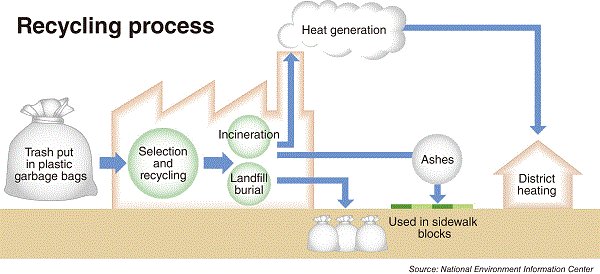Having lived in the United States since her childhood, 27-year-old graduate student Lee Hee-jung was surprised when she saw her roommates sifting through the garbage to separate milk cartons from trash bags filled with paper.
“Back in the U.S., I would lump together trash and put it on the road where trash operators would pick it up. Since recycling is not mandatory in our state, that was pretty much all I had to do. Now I struggle here with my roommate nagging me for not following the recycling regulations that are so strict,” said Lee.
These “strict” recycling regulations were introduced in 1995 and require residents and business operators to separate out trash that can be recycled, such as plastics, glasses, cans and milk cartons.
Paper, plastics, cans and other recyclable waste must be separated from household trash and be thrown out at a designated area for recycling. Vendors come to the site regularly every week to pick up the recycled waste. Large trash, such as furniture and home appliances, must be dumped with a state-issued sticker attached to them.
More specifically, milk cartons must be separated from other paper trash because they are coated with hard-to-recycle materials such as vinyl and thus require an extended period of time to decompose. Broken glass and other sharp-and-pointed objects must be put in designated sacks, not trash bags.
Among the recyclable trash, items that can be reused are sold to vendors who collect them. Other items that cannot be reused, such as Styrofoam, are reprocessed for other purposes, such as construction materials.
“The separation of trash was officially mandated in 2003. The rule was set in law with a penalty imposed on violators. Since then, we have fostered recycling programs and reduced the amount of trash that otherwise would be buried,” said Son Kyung-pyo of the Environment Ministry’s resources recycling division.
According to the ministry’s statistics, per capita household waste was reduced to 0.94 kg per day in 2013 from 1.3 kg per day in 1994.
From 1994 to 2013, the rate of trash that was buried decreased from 81.2 percent to 9.6 percent and the amount of trash that has been incinerated has decreased from 15.3 percent to 6.4 percent. The rate of trash that has been recycled increased from 15.3 percent to 83.2 percent.

“Environmental benefits aside, recycling brings more economic benefits to countries that have a small landmass and few resources like Korea. Large countries like the U.S. spend a lot of money on traveling between recycling facilities, but small countries like us can save money by recycling,” Son said.
But Korea’s signature recycling system has sometimes upset residents because of its strict, and sometimes, ambiguous rules. In February 2015, Seoul city government announced that it would no longer accept regular trash bags that contained paper or plastic.
Following the announcement, Seoul residents were confused as to whether items such as toilet paper, diapers and sanitary pads should be included in the category of paper to be recycled, and refused to recycle them.
The government later explained it had used an “ambiguous” expression in the announcement and clarified that toilet paper, diapers and sanitary pads were not subject to recycling rules.
“The government recycling policy is a step in the right direction. But sometimes it is a bit confusing and ambiguous. Before implementing the policy, the government should communicate better with the public over the details,” said Kim Seoul-gi, a 58-year-old Seoul resident.
By Yeo Jun-suk (jasonyeo@heraldcorp.com)








![[Graphic News] More Koreans say they plan long-distance trips this year](http://res.heraldm.com/phpwas/restmb_idxmake.php?idx=644&simg=/content/image/2024/04/17/20240417050828_0.gif&u=)
![[KH Explains] Hyundai's full hybrid edge to pay off amid slow transition to pure EVs](http://res.heraldm.com/phpwas/restmb_idxmake.php?idx=644&simg=/content/image/2024/04/18/20240418050645_0.jpg&u=20240419100350)





![[From the Scene] Monks, Buddhists hail return of remains of Buddhas](http://res.heraldm.com/phpwas/restmb_idxmake.php?idx=652&simg=/content/image/2024/04/19/20240419050617_0.jpg&u=20240419175937)

![[KH Explains] Hyundai's full hybrid edge to pay off amid slow transition to pure EVs](http://res.heraldm.com/phpwas/restmb_idxmake.php?idx=652&simg=/content/image/2024/04/18/20240418050645_0.jpg&u=20240419100350)

![[Today’s K-pop] Illit drops debut single remix](http://res.heraldm.com/phpwas/restmb_idxmake.php?idx=642&simg=/content/image/2024/04/19/20240419050612_0.jpg&u=)